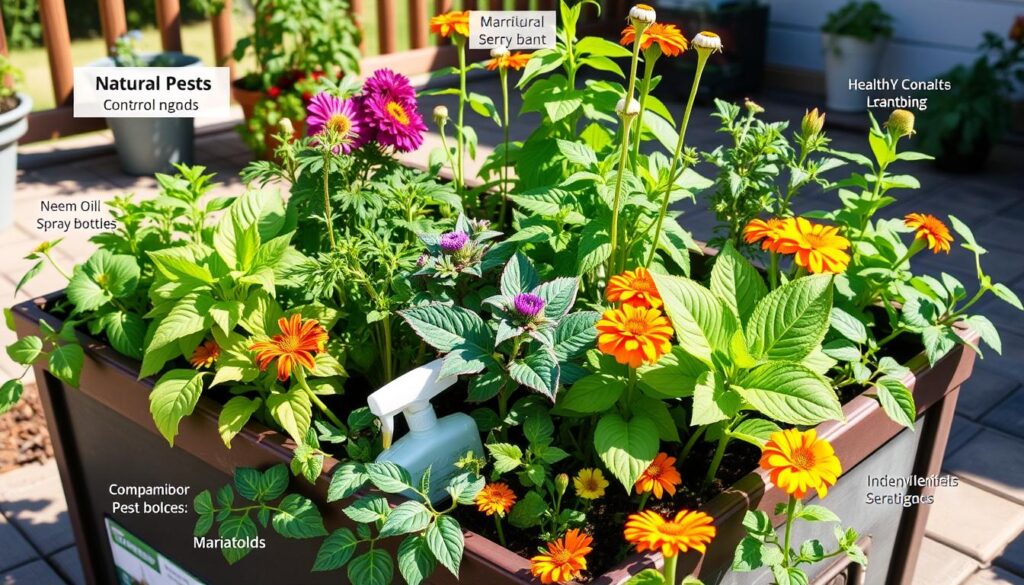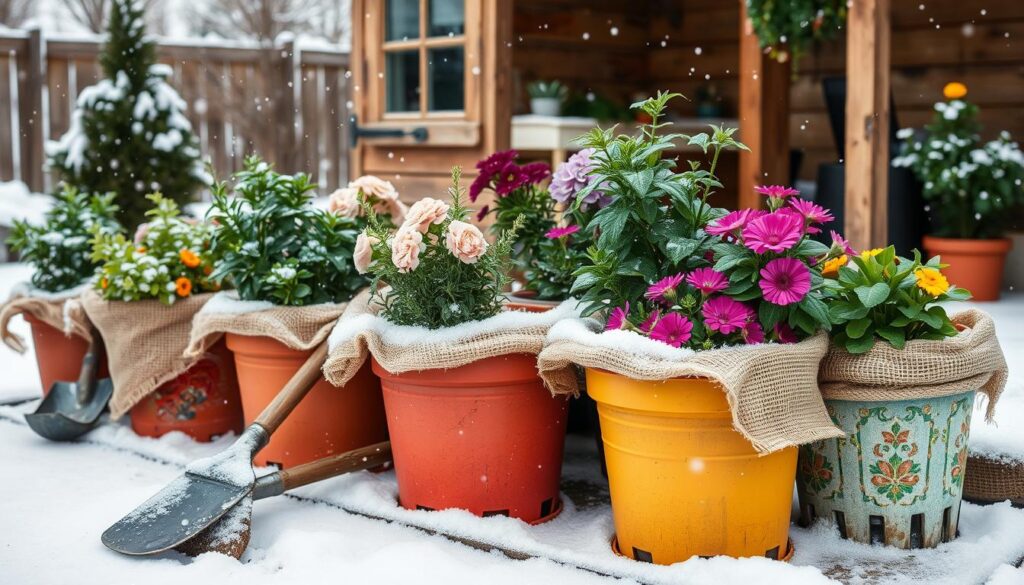Did you know you can grow a vibrant garden in tiny spaces? Container gardening is a great way to grow plants in cities. It also adds beauty to patios and balconies. By choosing the right containers and plants, you can make the most of small spaces. This article will share key tips for growing thriving plants and inspire your urban gardening ideas.
Container gardening is flexible and easy to maintain. It lets you place plants anywhere and choose from many varieties. Let’s see how to make your patio a lush oasis with smart strategies and expert advice.
Key Takeaways
- Understand the basics of container gardening for better growth.
- Select the right plants tailored for your containers.
- Utilize proper soil and fertilizer for optimal health.
- Establish a consistent watering routine.
- Recognize the importance of sunlight for plant vitality.
- Learn effective pest management techniques.
- Explore creative container arrangements to enhance your space.
Understanding Container Gardening Basics
Container gardening lets you grow plants in pots, from flowers to veggies and herbs. It’s a great way to garden without needing a big yard. You can use small spaces like patios, balconies, or windowsills.
What Is Container Gardening?
Container gardening means growing plants in pots instead of the ground. It’s flexible and lets you control the soil and water. You can move your plants to get more sunlight or to look better.
Benefits of Container Gardening
Container gardening saves space, which is great for city living. It also lets you control the soil and water, helping plants grow well. You can even garden in places with bad soil.
Choosing the Right Container
Picking the right container is key for a good garden. Think about size, material, and drainage. Here are some common choices:
- Clay pots: They’re pretty and let air in, helping with moisture.
- Plastic containers: They’re light and cheap, but hold water well.
- Recycled items: Old buckets or wooden boxes can be fun and eco-friendly.
Each container affects your plants differently. Pick one that fits your garden’s needs.
| Container Type | Advantages | Disadvantages |
|---|---|---|
| Clay Pots | Breathable, attractive | Heavy, can break easily |
| Plastic Containers | Lightweight, affordable | Less breathable, can fade |
| Recycled Items | Eco-friendly, unique | May not have drainage holes |
Selecting the Perfect Plants
Choosing the right plants for your container garden is key. The best plants for containers fit well in small spaces and are easy to care for. Mixing different plants adds beauty and function to your garden. We’ll explore the best plants for containers and suggest seasonal planting ideas.
Best Plants for Containers
Look for plants that do well in small spaces. Here are some top picks:
- Herbs: Basil, parsley, and chives add flavor and scent.
- Vegetables: Tomatoes, peppers, and lettuce are great choices.
- Flowers: Petunias, geraniums, and marigolds bring bright colors.
Seasonal Planting Suggestions
Plan your garden with the seasons in mind. Here’s a guide for seasonal planting:
| Season | Recommended Plants |
|---|---|
| Spring | Basil, pansies, snapdragons |
| Summer | Tomatoes, peppers, zinnias |
| Fall | Chrysanthemums, kale, asters |
| Winter | Winterberry, hellebores, ornamental cabbage |
https://www.youtube.com/watch?v=EqeH5gg0G4I
Essential Soil and Fertilizer Knowledge
Knowing the right soil for container gardening is key for your plants’ success. Container gardens need a special soil mix for good drainage and air. This mix helps roots grow well. Here are some top soil choices for container gardens.
Types of Soil for Container Gardening
- Potting Mix: A mix of peat moss, perlite, and vermiculite. It drains well and is light.
- Seed Starting Mix: Fine and full of nutrients, great for starting seeds.
- Organic Soil Mix: Made from natural stuff, it’s good for the earth and your plants.
With the right soil, managing nutrients is the next big step. Plants in containers use up nutrients fast. So, picking the best fertilizers for containers is crucial.
Choosing the Right Fertilizer
- Liquid Fertilizers: Quick and easy, they give plants a nutrient boost every few weeks.
- Slow-Release Fertilizers: They feed plants slowly over time, perfect for those who are busy.
- Organic Fertilizers: Safe and natural, great for plants you eat.
In short, picking the right potting soil options and fertilizers is vital. They help your container garden grow strong and healthy. Each part is important for your plants to thrive.
Watering Tips for Healthy Plants
Proper container plant watering is key for thriving plants. Knowing the watering frequency for each plant helps them grow well. The type of plant, the size of the container, and the environment all affect how often to water.
How Often to Water
Finding the right watering frequency involves a few important steps:
- Plant Type: Each plant needs a different amount of water.
- Container Size: Bigger pots hold water longer than smaller ones.
- Climate Conditions: Humidity and temperature affect how fast water evaporates.
Check the top inch of the soil to see if it’s dry. If it is, it’s time to water. Watching your plants closely helps you find a watering schedule that works for them.
Signs of Underwatering vs. Overwatering
Knowing the signs of stress in plants helps you tell if they need more or less water:
| Condition | Signs |
|---|---|
| Underwatering | Wilting, dry soil, and leaf drop. |
| Overwatering | Yellowing leaves, mold growth, and root rot. |
Spotting these signs lets gardeners adjust their container plant watering to keep their plants healthy.
Creating a Suitable Environment
To grow plants in containers well, you need to think about their environment. Picking the right location for container gardening is key for plant success. Whether you garden indoors or outdoors, knowing how to use sunlight is crucial for your plants’ health and growth.
Choosing the Right Location
The location you choose affects airflow, temperature, and humidity around your plants. Here are important things to keep in mind:
- Access to Sunlight: Place containers where they get enough sunlight, based on what your plants need.
- Proximity to Water: Make sure your container garden is easy to water regularly.
- Protection from Wind: Look for spots that protect your plants from strong winds that can harm them.
Importance of Sunlight Exposure
Plants need different amounts of sunlight to grow and bloom. Knowing what they need is vital:
| Light Requirement | Example Plants | Ideal Conditions |
|---|---|---|
| Full Sun | Tomatoes, Petunias | 6+ hours of direct sunlight |
| Partial Shade | Salvia, Ferns | 3-6 hours of sunlight, preferably in the morning |
| Indirect Light | Peace Lilies, Pothos | Bright but filtered sunlight |
By choosing the right spot for container gardening and giving plants the right sunlight, you can create a perfect environment for them to thrive.
Pest Management in Container Gardens
Container gardens face many pests that can harm plant growth and health. It’s key to control pests in container gardens to keep them thriving. By spotting pests early and using natural remedies, gardeners can safeguard their plants and foster a balanced ecosystem.
Common Pests to Watch For
Container gardens are often attacked by pests that damage plants. Here’s a list of common pests to watch out for.
- Aphids – Small, sap-sucking insects often found on new growth.
- Spider Mites – Tiny arachnids that thrive in hot, dry conditions, creating fine webbing.
- Whiteflies – Small, white-winged insects that can rapidly infest plants.
- Thrips – Slender insects responsible for skin damage to leaves and flowers.
Natural Remedies for Pest Control
There are many natural ways to fight pests in gardens. These methods are good for the environment and effective. Here are some top strategies:
- Introduce Beneficial Insects – Ladybugs and lacewings are excellent for controlling aphid populations.
- Neem Oil – This organic spray disrupts the life cycle of pests while being gentle on beneficial insects.
- Soap Sprays – A solution of diluted liquid soap can help mitigate aphid infestations.
- Homemade Garlic or Chili Sprays – These substances can deter a variety of pests without harmful chemicals.

Companion Planting Strategies
Companion planting lets gardeners make the most of their space and boost plant health. It’s about pairing crops to get benefits that help them grow better in containers. Knowing these companion planting techniques helps create spaces where plants thrive.
What Is Companion Planting?
Companion planting means growing certain plants together for mutual support. It’s based on the idea that some plants can keep pests away, taste better, and grow faster. For example, tomatoes and basil together not only help tomatoes grow but also add a scent that keeps bugs away.
Benefits of Planting Together
The benefits of companion gardening go beyond just looking good. Here are some key advantages:
- Plants grow better and produce more.
- Natural pest control comes from having different plants.
- Soil gets better and healthier.
- More plants can fit in the same space.
Choosing the right plants that grow well together makes gardening more sustainable. For instance, carrots and onions together keep pests away and help each other grow. This teamwork not only makes plants healthier but also increases harvests, making companion planting a smart choice for container gardens.
| Plant Pairing | Benefits |
|---|---|
| Tomatoes & Basil | Enhances flavor and repels pests. |
| Carrots & Onions | Deters root flies and improves growth. |
| Cabbage & Dill | Dill attracts beneficial insects and enhances cabbage growth. |
| Beans & Corn | Beans fix nitrogen in the soil, benefiting corn growth. |
Seasonal Maintenance Tips
As winter gets closer, it’s key to prepare your plants well. Container gardening needs extra care to keep plants healthy in cold weather. Using seasonal gardening tips can help your plants stay strong and live longer.
Preparing for Winter
To get your plants ready for winter, try these steps:
- Move containers to safe spots, like near a wall or under an overhang, to shield them from wind and frost.
- Water your plants less often since many go dormant and need less water in winter.
- Wrap pots in burlap or bubble wrap to keep them warm against freezing.
- Add mulch on top of the soil to keep moisture in and protect plant roots.
Signs of Seasonal Stress
Spotting plant stress signals early is crucial for keeping your plants healthy in winter. Look out for these signs:
- Discolored leaves can mean dehydration or a lack of nutrients.
- Wilting or droopy leaves show plants need more water or are shocked by temperature changes.
- Leaf drop means the plant is struggling with the cold.

By noticing these plant stress signals and following winter prep tips, you can keep your container garden healthy, even in tough seasons.
Creative Container Arrangement Ideas
Exploring creative container gardening can make your garden stunning. You can use plant layering or unique containers to make it a canvas for art. Here are some ways to improve your container plant arrangement.
Layering Plants for Aesthetic Appeal
Plant layering adds a dynamic look to your garden. Here are tips for a balanced and attractive setup:
- Height Variation: Use tall plants like Delphiniums or Sunflowers with medium-height plants like Petunias. Add ground cover plants like creeping thyme at the base.
- Color Coordination: Pick a color scheme that stands out. Mix contrasting colors, like purple petunias with yellow marigolds, for a striking display.
- Texture Diversity: Mix plants with different leaf shapes and textures. Ferns can contrast well with smooth-leaved succulents.
Using Unconventional Containers
Using unique containers lets your creativity shine. Here are some unconventional ideas:
- Old Wheelbarrows: A great rustic choice, perfect for larger plants or herbs, adding both utility and charm.
- Wooden Crates: These can create tiered effects when stacked or placed side-by-side, adding a cozy feel.
- Repurposed Items: Use vintage tin cans, teapots, or even shoes for personal flair. Don’t forget to drill drainage holes for plant health.
By mixing height, color, and texture in your arrangements, and using unique containers, you can turn any space into a vibrant sanctuary. Each choice shows your unique personality and enhances your planted designs.
| Container Type | Advantages | Best Plants to Use |
|---|---|---|
| Old Wheelbarrow | Spacious, rustic aesthetic | Sunflowers, Zinnias |
| Wooden Crates | Versatile stacking options | Herbs, Petunias |
| Vintage Teapots | Charming, quirky look | Succulents, small ferns |
Troubleshooting Common Problems
Container gardening is rewarding but can have its challenges. It’s important to know the signs of plant stress. Look out for yellow leaves, wilting, and slow growth. With some knowledge, you can find solutions to these issues.
Identifying Plant Stress Symptoms
Knowing the signs of plant stress is key to fixing container gardening problems. Here are some common symptoms:
- Yellowing Leaves: This often indicates nutrient deficiency or improper watering.
- Wilting: A sign that the plant may be underwatered or suffering from root rot.
- Stunted Growth: May suggest that the plant is in a too-small container or lacking essential nutrients.
Solutions for Common Issues
Using the right solutions can solve many problems. Here are some approaches:
- Adjust Watering Practices: Check soil moisture before watering. Ensure proper drainage to prevent root rot.
- Optimize Fertilizer Application: Use a balanced fertilizer to address nutrient deficiencies, following the recommended dosage.
- Pest Management: Inspect plants for pests regularly. The application of natural remedies such as neem oil can be effective.
Expanding Your Container Gardening Skills
To master container gardening, keep learning. Many resources are out there to help you grow. Online courses on Coursera and MasterClass teach by experts in horticulture. They cover from basic botany to advanced gardening.
Books like “The Container Gardening Handbook” by Sue Fisher are also great. They offer insights and tips to improve your gardening.
Resources for Further Learning
Reputable websites like the Royal Horticultural Society have lots of free content. They have articles, videos, and guides on container gardening. These can help when you face challenges or want to try new things.
Staying current with these resources can also spark creativity. It helps your plants do well in any spot.
Joining Gardening Communities
Joining local gardening groups or online forums is a big plus. It lets you share and learn from others. Local community gardens often have workshops where you can learn from pros.
Reddit and Facebook have groups for container gardeners. You can ask questions, share your wins, and get support. This community feeling makes gardening more fun.
FAQ
What are the best plants for small spaces in container gardening?
Herbs like basil, cilantro, and chives are great for small spaces. Cherry tomatoes and peppers are also good choices. Flowers like marigolds and petunias add color and thrive in containers.
How often should I water my container plants?
Watering frequency depends on plant type, container size, and weather. Check soil moisture daily in warm weather. Container plants need more water than garden beds, but avoid soggy soil.
Can I grow vegetables in containers?
Yes, you can grow vegetables in containers! Choose compact varieties like lettuce and spinach. Use good potting soil and plenty of sunlight for best results.
What are some urban gardening ideas for balconies?
For balcony gardens, use vertical gardening to save space. Try wall planters, hanging baskets, or shelving. Mix edible plants with flowers for a beautiful and useful space.
Are there specific container gardening tips for indoor plants?
Yes! Choose plants that do well in low light, like pothos. Make sure containers have drainage holes and use well-aerated potting soil. Rotate plants for even light and watch humidity.
How can I manage pests in my container garden?
Manage pests with natural remedies. Watch for aphids and spider mites. Use beneficial insects or organic sprays. Companion planting can also help keep pests away.
What nutrients do container plants need?
Container plants need balanced nutrients since soil depletes quickly. Use a good potting mix with slow-release fertilizers. Supplement with liquid fertilizers every few weeks during growing season.
How do I prepare my container garden for winter?
To prepare for winter, move containers to sheltered spots. Water less as growth slows. Protect plants with frost blankets. Bring tender plants indoors as it gets colder.
Can I use recycled materials for containers?
Yes! Use old buckets, wooden crates, or tin cans for containers. Make sure they have drainage holes and are safe for edibles. It’s creative and eco-friendly, adding a unique touch to your garden.


